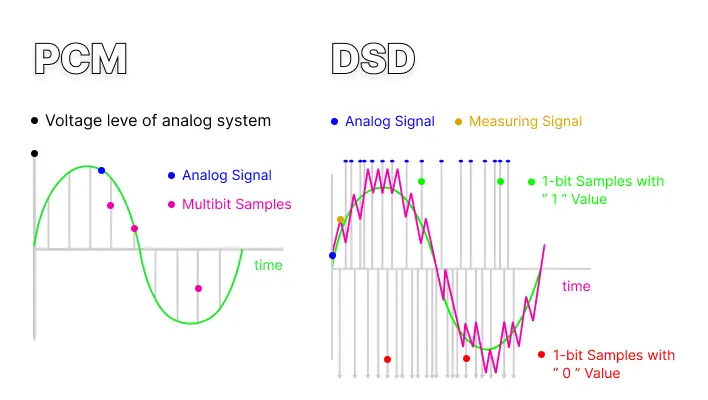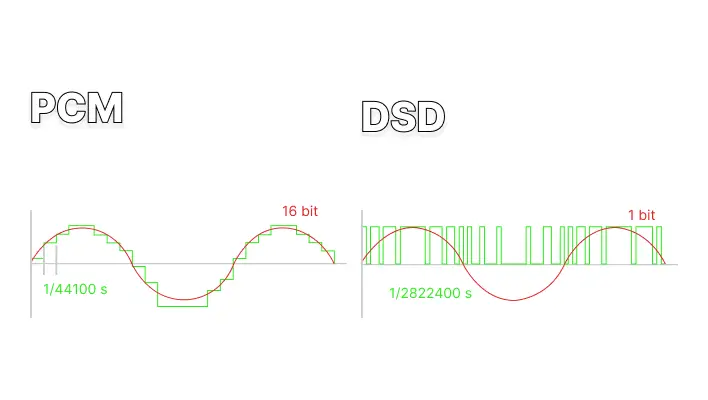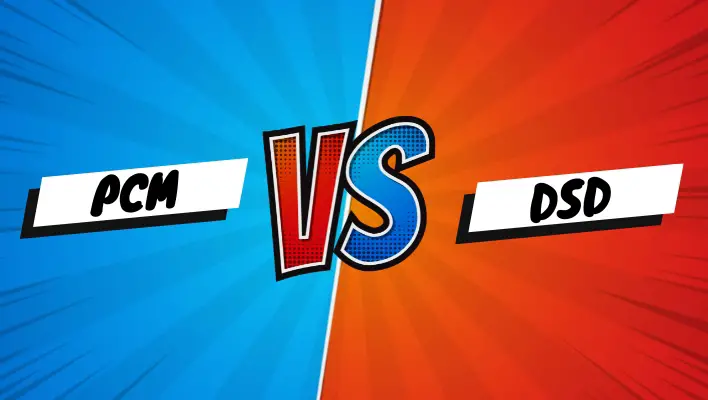If you’re a music lover, you’ve probably heard about the differences between PCM vs DSD. These two technologies offer excellent audio quality but do so in very different ways.
PCM is a short form of Pulse Code Modulation, while DSD means Direct Stream Digital. Both of these formats were developed to improve the sound quality of digital recordings. They do this using advanced coding techniques that allow more accurate reconstruction of sound waves captured at extremely high rates (typically 192kHz or higher).
Audiophiles widely use DSD because it can capture sound more accurately than PCM. The difference is most noticeable when listening to music with vocals, where there’s lots of high-frequency information in the recording. PCM tends to smooth out some of this detail, while DSD preserves it more faithfully.
This article delves into the differences between these two audio formats and shows you the one best suited for your use. So, read on.

What is PCM?
Pulse-code modulation (PCM) is a method of converting digital data into an analog signal. It uses high-frequency signals to stand for digital data, while low-frequency signals stand for audio.
The technique involves using high-frequency signals to represent the digital information in its original form and then converting it into an analog signal. When this happens, changes in the electrical properties of a wire or other object can be used to indicate changes in the information being transmitted.
This type of digital audio coding was originally developed in the early 1930s and used by early CD players to play back music files. The original PCM format had a 44.1 kHz sample rate. This means it had 44,100 samples per second when played back at a rate of 22,050 Hz.
Alec Reeves, the British engineer, first developed pulse-code modulation in 1937. It gained widespread attention after NASA used it to send information through satellites during the Apollo program. Today, PCM is widely used to transmit information between computers and digital devices such as smartphones and tablets.
PCM stores and manipulates digital data by encoding it as a series of on-off pulses. The frequency of these pulses changes according to what the computer wants to encode into the signal.

Pros and cons of Pulse-code Modulation
Pros:
- It’s less expensive than frequency modulation (FM), which increases the bandwidth required to transmit audio.
- It uses less power than AM, which means you can use larger antennas at a lower cost.
- The same technique works well with voice, data and video signals.
- It can transmit large amounts of data over long distances.
- It can be used to send data to a remote device without needing an interface card.
- Pulse-code modulation does not require additional equipment beyond the interface card itself, making it very cost-effective for small data transfers.
Cons:
- The speed at which it transmits data is limited by how fast the computer works and how much memory it has available;
- The receiver needs to be able to decode the pulse code. This means that if the receiver is not specifically designed for this type of transmission, you will be required to purchase an additional device in order to receive your data.
What is DSD?
DSD stands for “direct stream digital” and is an extension of PCM that improves audio quality by adding a higher sample rate (48 kHz) and better signal-to-noise ratio (SNR). In addition to improving sound quality, DSD also allows for lower bit rates than PCM so that more data can fit into the same space with fewer compression artifacts. This can result in smaller file sizes that require less storage space on your hard drive or mobile device than standard-quality MP3s or AAC.
Direct Stream Digital (DSD) audio format uses an open, nonproprietary method to encode audio data. It is designed to replace the current SACD format, which uses proprietary compression methods and is not compatible with any other digital audio player.
The main advantage of DSD over PCM is that it provides a better representation of the original signal, making it easier to synchronize multiple devices and make recordings.
DSD uses a sampling rate of 2-channel 16 bit/44 kHz and allows up to 192 kHz sampling rate. This allows for greater precision in reproducing sounds than PCM does, which means that DSD produces higher-quality audio.
The concept behind Direct Stream Digital was first introduced by Sony in 2001 when they announced their intention to release a new format for high-resolution audio called Super Audio CD (SACD). However, they decided against releasing it due to technical issues related to developing hardware for this format.
Pros and cons of Direct Stream Digital
Pros:
- It provides a higher resolution and quality than CD or SACD. This is due to the fact that the data rate is more than double when compared to PCM (coherent) bit-streams.
- It can be played on any audio player or computer with a digital input and output.
- It has the highest resolution of any digital audio format.
- It has the highest sample rate available in a digital audio format.
- It also provides low jitter and noise.
- It can record uncompressed PCM at the native sample rate.
- It can be played on PCs, Macs, and all consoles that can play DSD files.
Cons:
- The main disadvantage of DSD is that it’s not supported by all devices and players, such as non-DSD players or DACs. This is due to the extra processing required to convert between the two formats. Some players out there still don’t support DSD, but they’re slowly becoming obsolete as new ones are released every year.

Similarities Between PCM and DSD
PCM and DSD are bit-stream digital audio formats that share the following key similarities.
- They both use the same sample rate (44.1 kHz) and channel configuration (2 channels).
- Both can be used with similar compression levels, limiting, gain-staging, and other audio processing techniques.
- In terms of audio quality, both formats use 16-bit audio samples at a 44.1kHz sampling rate and 16 bits per channel (although the actual resolution depends on bit depth). However, DSD is a highly compressed format; thus, it offers better sound quality compared to PCM at the same bit depth.
- Both use audio samples stored in memory that are then converted into digital signals before being sent from the device to speakers or headphones via an analog headphone jack.
Differences Between PCM and DSD
There are several differences between PCM and DSD. Here’s a summary of the most important ones:
- PCM is a lossy process, while DSD is not. This means you will lose some information with PCM compared to DSD. The amount of information lost depends on the bit depth of your audio file.
- DSD files are more error-prone than PCM files. If you create an MP3 or WAV file from a DSD file, it will be more likely to have problems like clipping or distortion.
- DSD files are more efficient at converting data into sound than PCM files. So, they can be used when you want better sound quality but don’t have enough storage space for high-quality files like FLAC or AIFF. However, PCM may be a better choice if you’re just looking for better sound quality without any other benefits, such as increased efficiency.
- Another difference between them is that PCM uses an analog signal to store digital data, while DSD uses a digital signal to represent an analog signal.
Final Word
As we have seen, DSD and PCM digital audio formats differ greatly in how they work and what degree of quality you can expect from each one. They are designed for different purposes, but both have their uses.
However, at the end of the day, DSD is truly the more accurate format. Yes, it has its share of drawbacks, such as its high resolution, lack of compatibility and critical mastering limitations. But it is a more advanced audio format than PCM and can offer better sound quality.
Be aware, however, that it is more complicated to work with, so it might not be worth the effort if you aren’t an audiophile or have limited resources.
PCM offers slightly lesser sound quality than DSD but requires fewer resources to decode the file. PCM might be your best option if you’re looking for a good balance of performance and ease of use. It offers you the best of its enhanced dynamic range compared to CD while maintaining a smaller file size. All the best in choosing your perfect fit.
